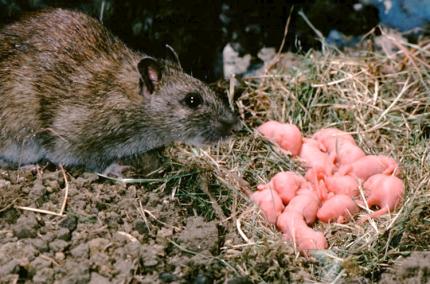
Washington is home to both native and non-native rats, the latter sometimes being referred to as Old World rats. Native to the Orient, Asia Minor, and Siberia, Old World rats were introduced to North America on the ships of the early voyagers. These highly adaptable rats continue to enter new regions on board any transportation they can gain access to -- from ships to trains and trucks carrying freight and other goods around the world. In Washington, they are now found wherever humans have established permanent residence or industry.
Old World rats are active all year, mostly at night. However, when disturbed (weather change, construction, etc.), hungry, or when living in crowded conditions they are seen at any hour.
Facts about Washington rats
Food and Feeding Behavior
- Old World rats will eat anything humans or livestock will eat, plus many less palatable items including animal droppings, garbage, and other rats.
- Rats living apart from human habitation are know to eat seeds, nuts, and insects, as well as young birds and bird eggs.
- When given a choice, rats select a nutritionally balanced diet, choosing fresh, wholesome items over stale or contaminated foods.
- Rats begin foraging soon after dark and most of their food gathering occurs before midnight. They often store or hoard food in hidden areas.
- The main constraint of rats is they cannot live long without water if their diet doesn't contain adequate amounts of liquids.
- Food items in household garbage offer a fairly balanced diet and also satisfy their moisture needs.
Territory and Family Structure
- Old World rats travel 50 to 300 feet from their nests to look for food and water and patrol their territory. However, they can travel much farther when necessary.
- Rats generally live together in a group dominated by a large male that guards a harem of females and aggressively prevents other males from mating.
- Rats seen during the day are generally socially low-ranked individuals who have been denied access to food by dominant rats during the night.
Nest Sites
- Roof rats build nests in attics, trees, and overgrown shrubbery or vines. Roof rats rarely dig burrows for living quarters if off-the-ground sites exist.
- Norway rats prefer to nest at or under ground level, and in the lower floors of buildings.
- Rats can have several nest sites. They may spend a week in their primary nest site, and then move for a day or two into an alternate nest site.
- Due to their daily need to drink water, rats prefer to nest where water is easily available.
Reproduction
- Old World rats breed year-round, but reproduction is concentrated in the warmer months.
- A litter of six to ten young are born after a gestation period of about three weeks.
- Young rats are weaned at around 20 days of age and can breed at three to four months of age.
- Younger rats will mate in the same location in which they were born or will migrate to a new, unoccupied territory.
Mortality and Longevity
- Old World rats are killed by vehicles, traps, poisons, or other rats. Some domestic cats and dogs capture rats, usually small ones.
- Owls, hawks, foxes, coyotes, and weasels prey upon rats; snakes eat immature rats.
- The average life span of a rat in the wild is less than one year, with females living longer than males.
Common rats of Washington
Old World rats include the Norway rat (Fig. 1), also known as the brown rat, sewer rat, or wharf rat, and the black rat, also called the roof rat.
The Norway rat (Rattus norvegicus), averages 16 inches in length, including the animal's long, tapered, scaly tail that is slightly shorter than the combined length of the rat's head and body. Norway rats are grayish-brown in color from top to bottom; white, black, or mottled individuals are occasionally found. The rats used in laboratories and sold as pets are specially bred strains of Norway rats.
While early scientific descriptions of this species came from Norway, and it was once believed to have arrived in England aboard Norwegian ships, the "Norway rat" is neither a native of Norway nor more common there.
The black rat (Rattus rattus) is similar in length to the Norway rat, but are slenderer and darker. The tail is longer than the combined length of the head and body. As one of their names implies, roof rats are agile climbers and are found on roofs and in the upper levels of buildings. Preferring saltwater-influenced warmer climates, and being more likely to board ships than Norway rats, black rats are often seen in port cities and coastal towns.
Viewing rats
It is not easy to tell how many rats are using an area. However, you can use their signs as a rough guide to whether the population is low, medium, or high. Use a powerful flashlight to search for their sign in dark places and to spot the animals after dark.
Where rat numbers are low, no sign other than a burrow entrance 2 to 4 inches in diameter may be seen.
In a medium-populated area, droppings and gnawings can be found, and rats will be heard in or under a structure at night. In addition, cats and dogs may excitedly probe an area of floor, wall, or other area where rats are present, especially if rats have only recently entered.
When a high rat population is present, fresh droppings and signs of gnawing will be common. Also, rats may be seen and heard both day and night.
Burrows
Norway rat burrows are found singly or in groups along building foundation walls, under slabs, in overgrown weedy areas, beneath debris and buildings, and in moist areas in and around gardens and fields (Fig. 2). Active burrow entries are 2 to 4 inches in diameter, free of dirt, leaves and spiderwebs, and are surrounded with smooth, hard-packed soil. A fresh entry will have soil pushed out in a fan-shaped pattern.
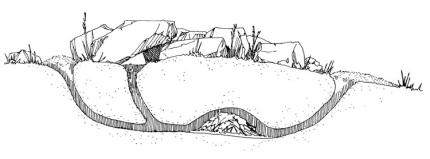
To determine if an existing burrow is occupied, fill the entry with some wadded-up newspaper, leaves, or dry soil. If rats are using the burrow, they will reopen and clear the hole in a couple of days during good weather.
Trails
Rats tend to travel the same route—along walls, along fences, under bushes—nightly. Trails appear as narrow (wide enough for only one rat), worn paths. Roof rats can often be seen at night running along overhead utility lines or fence tops.
Tracks
Rat tracks appear in dust or soft, moist soil. A rat's footprint is about 1/2 inch long and shows four or five toes. Rats may also leave a tail dragline in the middle of their tracks.
Rat (and mouse) tracking patches can be placed in suspected rat areas to reveal footprints. A tracking patch is a light dusting of an inert material such as clay, talc (unscented baby powder), or powdered limestone. Don't use flour, which can attract rats and other animals. A suitable patch size is 12 x 4 inches. When inspecting tracking patches, shine a flashlight at a low angle, causing the tracks to cast distinct shadows.
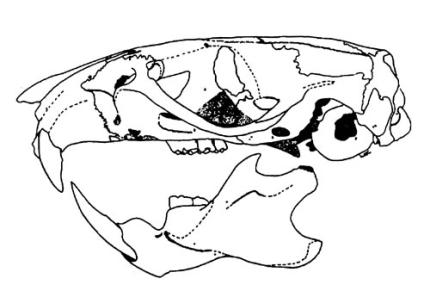
Droppings
A single rat can produce 50 droppings daily. Most droppings are found where rats rest or feed. Fresh droppings are black or nearly black, look wet, and have the consistency of putty. After a few days, droppings become dry, hard, and have a dull appearance. After a few weeks, droppings become gray and crumble easily.
Note that old droppings moistened by rain look like new droppings; however, if crushed, they will crumble.
Gnawing
A rat's incisor teeth grow at the amazing rate of 5 inches per year (Fig. 3). Rats keep their extremely hard teeth worn down by continuously working them against each other and by gnawing on hard surfaces. Look for signs of gnawing on floor or ceiling joists, door corners, siding, and around pipes in floors and walls.
Rub marks
Body oil and dirt rub off of rats' coats and can become noticeable along frequently used trails. Look along wall/floor junctions, where rats move around obstacles, and at regularly used openings in walls, floors, and ceilings.
Sounds and Smells
Old World rats make squeaks and fighting noises, as well as clawing, scrambling, and gnawing sounds in the walls and other parts of buildings. These sounds may be so loud it seems a larger animal is present. Areas occupied by rats often have a musky smell. One dead rat can cause considerable odor.
Preventing conflicts
In the process of seeking food and shelter, Old World rats can contaminate human or domestic animal food with their droppings, destroy insulation, and create noise in attics, walls, and crawl spaces. Rats also chew on electrical wiring and structural supports in buildings. Norway rats occasionally burrow into dikes and dams. Both species can damage garden crops and ornamental plantings.
Successful long-term rat control is not simple; a continuing commitment to whatever solutions are adopted is required. Within a population, some rats will be easy to control, some difficult. Complete control is often not possible in old barns and similar structures. Rat populations may also be a consequence of community-wide activities over which you have little control—improper garbage disposal, building demolition, and poorly maintained bird-feeding stations.
If you think you can solve a rat problem with a house cat, remember that cats allowed to roam outdoors may also kill songbirds, chipmunks, snakes, lizards, and young rabbits and squirrels. In addition, although a cat may kill a young rat, after one experience with an adult rat, cats often prefer to seek easier prey.
The following recommendations ideally should be followed before rats enter areas where they are unwanted and before the numbers of rats becomes extreme.
Prevent Access to Food and Water
This includes managing areas both inside buildings and their surroundings.
Store human and animal food in rat-proof buildings, rooms, or containers. Old World rats are very capable of chewing through heavy-duty plastic garbage cans when they can get started chewing on a corner or the lid or a handle. Use metal garbage cans where this is a problem.
Prevent raccoons and other animals from making garbage available. Keep your garbage-can lid on tight by securing it with rope, chain, bungee cords, or weights. Better yet, buy garbage cans with clamps or other mechanisms that hold lids on. To prevent tipping, secure side handles to metal or wooden stakes driven into the ground. Or keep your cans in tight-fitting bins, a shed, or a garage. Put garbage cans out for pickup in the morning, after raccoons have returned to their resting areas.
Prevent access to fruit and compost. Don't put food of any kind in open compost piles; instead use a rat-proof composter or a covered worm box. If burying food scraps, cover them with at least 8 inches of soil and don't leave any garbage above ground in the area—including a smelly shovel. Keep all open or lightly covered compost piles the consistency of a wrung out sponge to make them unfavorable to nesting rats.
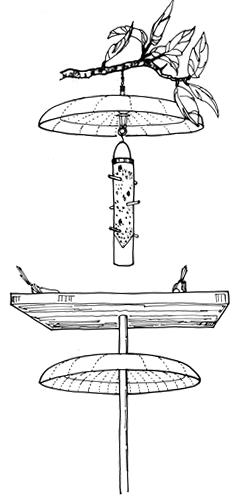
Pick up fruit that falls to the ground. Don't allow garden produce to rot on the vine. Compost it, or rototill or dig it into the soil.
Feed dogs or cats inside and clean up droppings. One of the most common attractants around homes is pet food. The strong smell attracts rats from a distance. Once they get a taste of these nutritious foods they will try to feed there daily. If you must feed pets outside, pick up food and water bowls, as well as leftovers and spilled food, before dark. Also, clean up pet droppings—rats can subsist on a diet of droppings.
Prevent access to bird feed and feeders. Pet food and birdseed are the two items that attract the most rats around buildings. Once rats get a taste of these nutritious foods they will try to feed there daily. Place baffles above and below feeders to prevent rats from gaining access to feeder foods (Fig. 4). Rats are attracted to the smell of seed hulls, so rake up the shells or offer birds hulled sunflower seeds (also known as sunflower hearts or chips). For more information on feeder management, see "Tree Squirrels."
Eliminate access to water. Fix leaky outdoor faucets and, where practical, eliminate access to other sources of ground water.
Prevent Access to Shelter
In the long term, the most successful form of rat control is to build them out. Also called rat-proofing, this approach makes it impossible for rats to get inside or under a building where they could do damage.
Both Norway and roof rats may gain entry to structures by gnawing, climbing, jumping, or swimming through sewers and entering through the toilet or broken drains. While Norway rats are more powerful swimmers, roof rats are more agile and are better climbers.
It is always easier to keep rats out of buildings. Once they are inside, controlling them requires more work, cost, and aggravation.
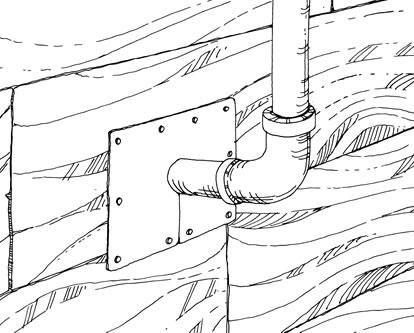
Eliminate access into buildings. To enter a building, rats only require a hole 1/4-inch in diameter to chew larger and squeeze through. Seal openings around drainpipes, vents, power lines, cables, and other utilities that enter structures (Fig. 5).
Seal cracks and holes in building foundations and exterior walls (including warped siding) and roof joints. Seal all the above mentioned areas with 1/4-inch mesh hardware cloth, metal flashing, stuff-it, copper Stuf-fit®, mortar, or concrete patch. It's possible to temporarily stuff balled-up galvanized window screening, copper or stainless-steel mesh scouring pads (steel wool quickly corrodes after becoming wet) into cracks, holes, and other openings.
Install commercially available vent guards to prevent rats from entering bathroom exhaust vents and dryer vents. Basement drains should be screened. If the drain is no longer used, seal it.
Rodent-proofing against roof rats usually requires more time to find entry points than for Norway rats because of roof rats' greater climbing ability. Roof rats often enter buildings at the roofline area so be sure that all access points in the roof are carefully inspected and sealed.
Prevent rats from climbing buildings
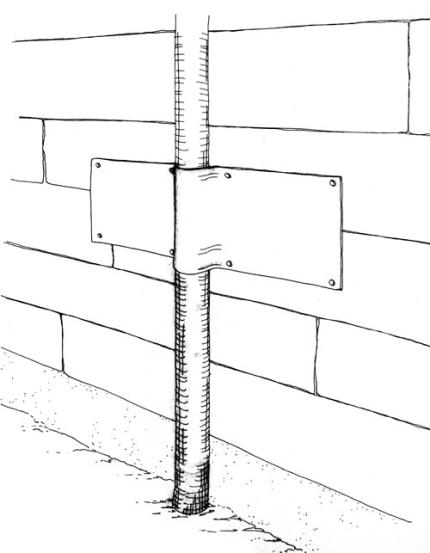
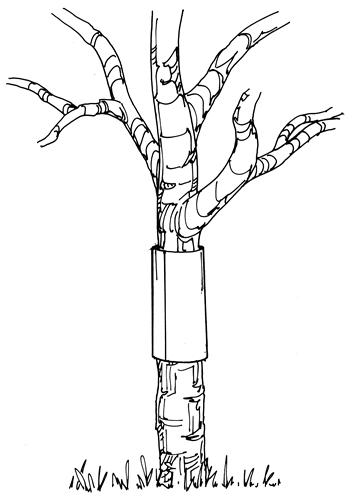
Both roof rats and Norway rats are excellent climbers. Place metal or heavy plastic barriers around trees and over pipes and other places rats climb and gain access into buildings (Fig. 6).
If rats are traveling on overhead utility wires, trim tree branches at least 4 feet away from utility lines that lead into structures. Contact the utility company for information on measures that can be taken to prevent rats from using these lines. To prevent rats from climbing trees, install a tree guard (Fig. 7).
Remove vines, such as English ivy, which provide rats a way to climb structures and hide their access points. (Ivy also facilitates rats' entry into the tree canopy, where they can prey on nestling birds.)
Keep doors closed, especially at night. Rats can find easy access into buildings under doors (including garage doors) and through open or poorly fitting doors. Once in a garage, rats gain entry into the main structure via holes around pipes, furnace ducts, and drains. Cover door bottoms that are subject to gnawing with metal flashing or hardware cloth, and keep the openings no larger than 1/4 inch.
Keep ground areas around structures open. Keep a 4-foot wide space next to buildings mowed and free of thick vegetation, wood piles, and debris to allow for easy inspection. Materials stored in stacks or piles should be on pallets at least 12inches off the ground—higher will allow for easier inspection. Ornamental shrubs next to the house should be pruned up at least 18 inches from the ground.
Remove the Existing Rat Population
If rat problems persist after you've eliminated all known sources of food and shelter, some form of population reduction, such as trapping or baiting, is almost always necessary.
Rats are wary animals, easily frightened by unfamiliar or strange noises. However, they quickly become accustomed to repeated sounds, making the use of frightening sounds, including high-frequency and ultrasonic sounds, ineffective for controlling rats in home and garden situations.
Rats have an initial aversion to some odors and tastes, but no repellents have been found to solve a rat problem for more than a very short time.
A one-way door allows rats to exit a structure, but prevents them from finding their way back in the same door. Unfortunately, a rat may try and enter the structure elsewhere.
Lethal Control
Trapping and poisoning are common methods to lethally control Old World rats. Neither will provide long-term control if attractions are not removed and areas where rats are entering buildings are not repaired.
Many companies and individuals make a portion of their living from handling rat-related problems. Before hiring any work to be done, read the guidelines in "Hiring a Wildlife Damage Control Company."
Because rats are neophobic (wary of changes in their environment), a trap or bait station may be avoided until the rats become familiar with the new objects along their travel routes. Even then, they will approach cautiously. If the trap triggers, or poison bait only makes a rat ill, a rat will avoid similar traps or baits in the future.
In addition, if the mother rat has become wary of poison baits or traps, her young may learn to avoid them. This learning experience can make trapping and poisoning difficult in sites where control programs have occurred recently.
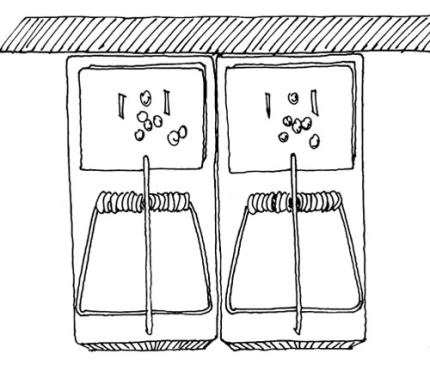
Trapping has several advantages: It does not rely on potentially hazardous poisons; it permits users to verify their success; and it allows for disposal of trapped rats, thereby eliminating dead-rat odors that may occur when poison is used. Many styles of rat traps are available:
Snap traps: Snap traps and other lethal traps are thought to be more humane than the use of poison because traps generally kill the rats instantly.
The traditional snap trap, or one of its variations, is an effective tool for killing rats, especially when there are only a few rats in a limited area. Traps made with expanded triggers are much more effective than those with small metal triggers (Fig. 8). Rats will easily clean the bait off the old metal-trigger traps, but doing so is harder with the expanded version. Most supermarkets, hardware stores, or farm supply stores carry snap rattraps. Professional models are available from pest control companies and Internet vendors.
Don't set snap traps outside of a structure. Otherwise a chipmunk, raccoon, ground-feeding songbird, pet, or other animal may spring the trap—killing or injuring the animals.
If trapping outside is necessary, use a trapping box. Commercial trapping boxes hold two traps, and have one or two small entrance holes (Fig. 9). A trapping box also can be made from a wooden box with 2-inch entry holes at ground level. Place two snap traps facing each way inside, making sure the traps can operate freely with the lid closed. To minimize the possibility of trapping non-targeted wildlife, especially in rural areas, set the trapping box out at night and retrieve it—or cover the holes—at daybreak. Not retrieving the box early enough could mean the death of a curious chipmunk or other small animal.
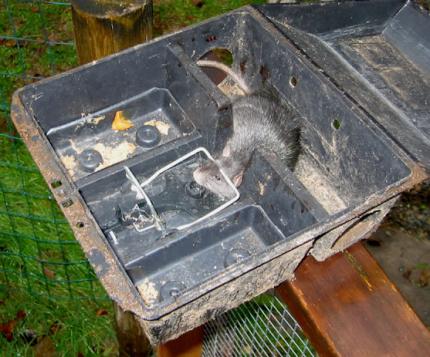
Rats have a highly developed sense of touch due to sensitive body hairs and whiskers which they use to explore their environment. They prefer a stationary object on at least one side of them as they travel, thus they commonly move along walls. Such knowledge is helpful when placing traps (Fig. 8).
Check all traps daily to reset any sprung traps and remove dead rats as quickly as possible. This is important to insure others won't become shy of the trapping device. Because rats may carry diseases, do not handle them without gloves; you can use a plastic bag slipped over your hand and arm as a glove. Once the rat is removed from the trap, hold it with your bagged hand and turn the bag inside out while slipping it off your arm and hand.
Old World rats are wary animals and careful attention to detail is necessary to trap them. Here are some tips:
- Set traps out as soon as rats are detected.
- Set traps where evidence of activity is found—along walls, behind objects, in dark corners, or where the rat is forced through a narrow opening, such as in the tunnel where the rat enters and exits a building.
- Move boxes and objects around to create narrow runways leading to the traps.
- Use as many traps as are practical so trapping time will be short and decisive. A dozen traps may be necessary for a heavily infested home.
- Place the trigger side of the traps next to the wall (Fig. 8).
- Bait traps with peanut butter (which is difficult to lick off traps with expanded triggers), hot-dog slices, or bacon. If necessary, hold the bait on with a thread or a twist tie.
- If rats are traveling on rafters or pipes, fasten traps to them using screws, wire, or strong rubber bands. Secure the traps before setting them.
Glue boards: One of the alternatives to a snap trap is a glue board. Glue boards work on the same principle as flypaper: when a rat attempts to cross the glue board, the rodent gets stuck. One of the major drawbacks with glue boards (and other live-catch type traps) is that the trapped animal may not die quickly, and you will need to kill it. For this reason, glue boards are not a good alternative for many people and their use is not recommended. Glue boards also lose their effectiveness in dusty areas unless covered, and extreme temperatures also affect their tackiness.
Electronic traps: Traps that kill rats by electrocution are available on the market. These traps are considerably more expensive than the common snap trap and can be used safely and effectively only in limited situations. Like the snap traps, these traps catch only one rat at a time and then must be emptied. Twenty or more snap traps can be purchased and put to use for the price of one of the electrocution units. When compared with snap traps, electrocution traps have not shown sufficient advantages to promote their use.
Live traps: Live traps are not recommended because trapped rats must either be killed or released elsewhere. Releasing rats outdoors is not recommended because of health concerns to people and the damage they may cause elsewhere. Because neither the roof nor Norway rat is native to this country, their presence in the wild is very detrimental to native ecosystems. They have been known to decimate some bird populations.
Using poison bait is the least preferred method of controlling rats. In addition to the possibility of poisoning children, pets, and non-target species, one dead rat can cause a major odor problem. Also, fleas and mites often leave rat carcasses and may infest the entire house if the carcass is not removed promptly.
If poison bait is used outdoors it must be registered for such use, applied according to label directions, and placed in a bait box. Bait boxes are designed so children, pets, and non-target wildlife cannot access the bait, but a rat can. (Bait trays and flimsy plastic or cardboard boxes are not tamper-resistant.)
Bait boxes vary in type and quality of construction, but they are usually metal or heavy plastic; those designed for rats are larger than those used for mice. Small children may be able to slide their hands inside, but the bait is tucked away in chambers, which will be out of their small hands' reach. Bait boxes can be purchased from farm a supply store, hardware store, or pest control business over the Internet.
Clearly label all bait boxes "Caution—Poison Bait" as a safety precaution. Some poison-bait labels or situations may require the use of approved tamper-resistant bait boxes. If so, be sure to secure these boxes to buildings by nailing or otherwise securing them to walls or floors in a way that will not permit a person or animal to knock them over or shake the bait out.
Poison bait can be purchased packaged in a variety of formulations. Most baits contain one of several anticoagulants that prevent blood clotting, causing rats to bleed internally and die. (See "Pets, Wildlife, and Rodent Control" for important information.)
Check bait boxes periodically to make sure the rats are taking the bait and that the bait is fresh. Rats rarely feed on spoiled bait. Because rats fear new objects, the bait may not be eaten for a few days or a week.
Remove and properly dispose of all uneaten bait at the end of a control program. Also, collect and properly dispose of any dead rats found while baiting. Pick them up, using a sturdy plastic bag inverted on your hand, and seal them in the bag for disposal with household garbage, or bury them in a location where pets or scavengers will not easily dig them up.
Dried rat carcasses and skeletons indicate a past control effort using poison bait. Many fresh carcasses are an indication that poison bait is currently being used in the area.
Flooding: Norway rats may be drowned or flushed from their burrows with water from a garden hose. The entire tunnel system will need to be quickly and completely flooded to evict its tenants, which can be dispatched with a shovel or caught by a dog. Be careful when attempting to flood out a rat near a building—doing so could damage the foundation or flood the basement or crawl space. Concentrate the effort in late winter and early spring, before rats give birth. Fill all holes with dirt when done.
Smoking: Smoke or gas cartridges are registered and sold for the control of burrowing rodents. When placed into the burrows and ignited, these cartridges produce toxic and suffocating smoke and gases. Norway rat burrows may extend beneath a residence and have several open entrances, however, permitting toxic gases to permeate the dwelling. For this reason, and because fire hazards are associated with their use, smoke and gas cartridges are not recommended for rat control around homes.
Shooting: Controlling small, isolated groups of Old World rats with a pellet gun is effective. For safety considerations, shooting is generally limited to rural situations and is considered too hazardous in more populated areas, even if legal.
Follow-up: It is difficult to permanently rat-proof a structure—when houses settle new opportunities for reentry open up, and rats can chew a hole into or burrow under an unprotected structure at any time. Therefore, keep watch for any new rat sign (droppings, food damage, gnawing damage, burrow entrances, etc.).
Pets, Wildlife, and Rodent Control
Many of the methods and materials used to control rats and mice can affect pets and wildlife. All rodent baits are toxic to dogs, cats, and wildlife, so be cautious in their use. Because the anticoagulants are cumulative and slow acting, dead rats or mice may contain several lethal doses of toxicant, and secondary poisoning of pets and wildlife is possible if several carcasses are consumed over a few days.
While this secondary poisoning is possible, it is not common. Most fatalities in pets involve dogs and are due to the animal consuming the bait directly (primary poisoning) or a combination of direct bait consumption and secondary poisoning.
Anticoagulant baits used to be thought of as relatively safe baits to use around the house and garden because they required multiple feedings to be effective. With a reaction time of three to four days, and vitamin K as an antidote, the risk of accidental poisoning of humans and pets was considered low. Newer anticoagulant baits, however, have been developed that only require a single feeding to be effective and are, therefore, more hazardous to pets, children, and wildlife than the older type of anticoagulant bait.
Baits that require multiple feedings over a period of several days contain warfarin, chlorophacinone, or diphacinone as their active ingredient, whereas the single-feeding anticoagulants contain brodifacoum, bromadiolone, or difethialone.
Use extra caution with the single-feeding anticoagulant baits; exposure to even a single dead rat or mouse killed by these might be enough to cause poisoning in a pet or other animal. The great advantage of multiple-feeding anticoagulants is that a good antidote, vitamin K1, as well as whole-blood transfusions are available if medical attention is received early enough. Symptoms of anticoagulant poisoning in mammals include lethargy, loss of color in soft tissues such as the lips and gums, and bleeding from the mouth, nose, or intestinal tract.
Put bait in a tamper-resistant bait box in locations out of the reach of children, pets, domestic animals, and wildlife. The bait box must be resistant to destruction by dogs and by children under six years of age, and must be constructed in a manner that prevents a child from reaching into the bait compartments and obtaining bait. If bait can be shaken from the box when it is lifted or tipped, the box must be attached to stakes in the ground or otherwise immobilized. Clearly label all bait boxes with appropriate warnings, and store unused bait in a locked cabinet or other areas inaccessible to children and domestic animals.
Public Health Concerns
Among the diseases that can be spread from Old World rats to humans are bubonic plague, salmonella (food poisoning), leptospirosis, and tularemia.
If a person is bitten or scratched by a wild rat, immediately clean the wound by thoroughly scrubbing it with soap and water. Flush the wound liberally, using tap water. Contact a physician and the local health department. This same precaution applies if a person has handled an obviously sick rat that may be harboring a contagious disease. (Children are particularly inclined to handle lethargic small mammals.)
If you can place a large bucket over the rat and secure the bucket with a heavy object, the animal can then be held for inspection by a health official.
Legal Status
Old World rats are not considered to be wildlife and are therefore not regulated by the Washington Department of Fish and Wildlife. The killing of Old World rats is unrestricted.
Additional information
Books
Christensen, James R., and Earl J. Larrison. Mammals of the Pacific Northwest: A Pictorial Introduction. Moscow, ID: University of Idaho Press, 1982.
Corrigan, Robert M.; Rodent Control: A Practical Guide for Pest Management Professionals, 2001.
Hygnstrom, Scott E., et al. Prevention and Control of Wildlife Damage. Lincoln, NE: University of Nebraska-Lincoln, Institute of Agriculture and Natural Resources, 1994. (Available from: University of Nebraska Cooperative Extension, 202 Natural Resources Hall, Lincoln, NE 68583-0819; phone: 402-472-2188; also see Internet Sites below.)
Ingles, L. G. Mammals of the Pacific States. Stanford, CA: Stanford University Press, 1965.
Link, Russell. Landscaping for Wildlife in the Pacific Northwest. Seattle: University of Washington Press and the Washington Department of Fish and Wildlife, 1999.
Verts, B. J., and Leslie N. Carraway. Land Mammals of Oregon. Los Angeles: University of California Press, 1998.
Resources
Centers for Disease Control and Prevention